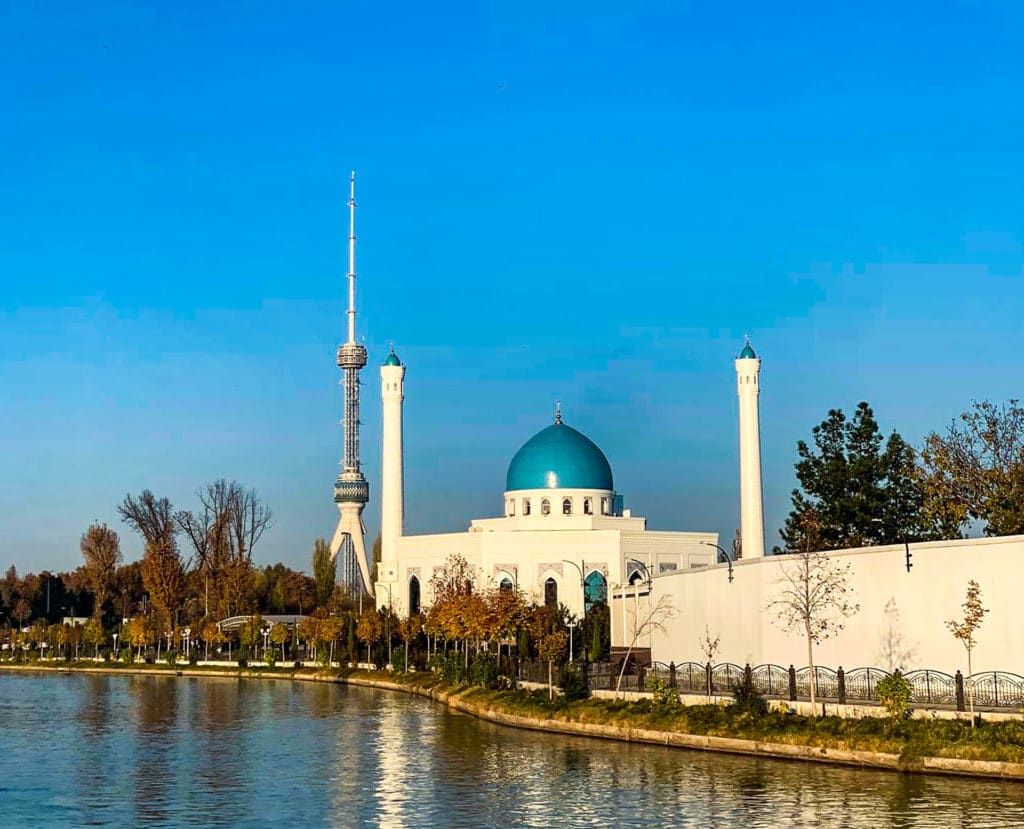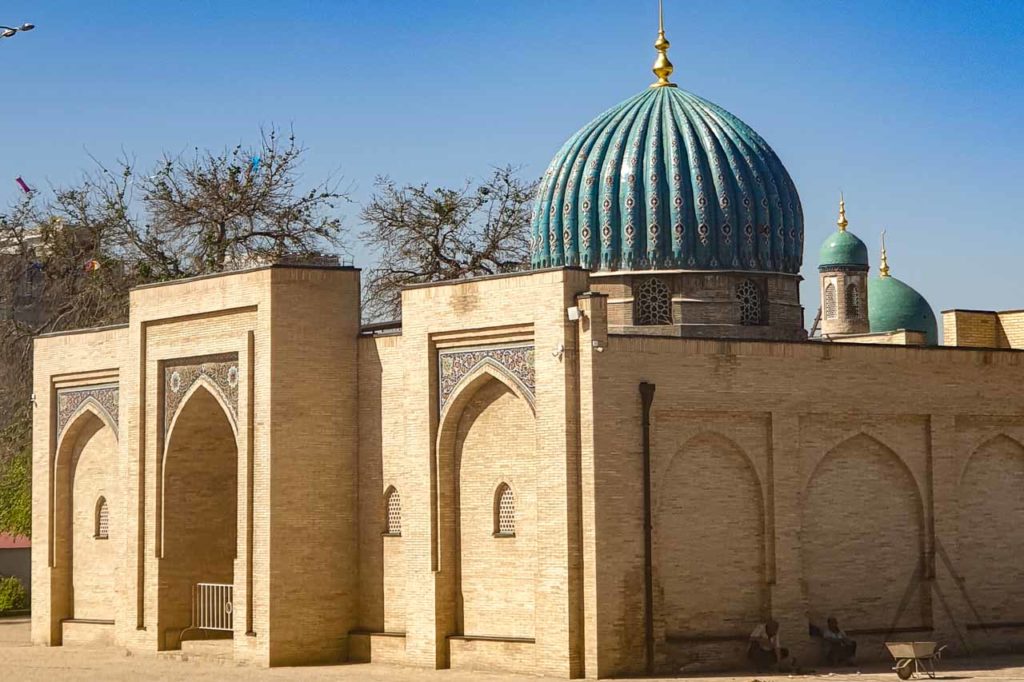Tashkent Mosques
and Churches
Tashkent Mosques
Tashkent Juma Mosque
The Juma Mosque is the basis of one of the main architectural collections of Tashkent and located in the area of Chorsu Square that also includes the Kukeldash madrasa. Although the current building of the Juma mosque was built only some years ago, it is based on one of the oldest architectural monuments in Tashkent.
The foundation of the mosque was laid on a high hill in the 9th century and it was the first mosque in Tashkent, after it was conquered by the Arabs. In 1451, by the investment of Sheikh Ubaydulla Khoja Akhrar, the spiritual leader of the Sufis and a descendant of the Prophet Muhammad, a unique cube with a dome and an arched roof opening to the east was built. For centuries, the mosque was visible from anywhere in the Tashkent city. The dome is round without decoration and is based on spherical shields. A curve of small corners at the entrance is lancet, not really Central Asian but more likely Gothic contour. The design of the mosque is elongated in the form of a box with a large building volume at the end of the east-west longitudinal axis.
The mosque was seriously damaged by the crushing earthquake of 1868, when also many other monuments of medieval architecture in Tashkent were damaged. After 20 years, it was restored with funds from the personal treasury of the Russian Emperor Alexander III and therefore people still call it the mosque of the Tsar. In Soviet times, the mosque was abandoned and fell into complete decline but after the Independance, in 1997, its ruins were demolished, and replaced with a new mosque.
Tashkent Minor Mosque
The Minor Mosque is one of the latest and largest mosques not only in Tashkent but in entire Uzbekistan. Construction of the minor mosque began in the summer of 2013 and it opened its doors for the eve of the holy holiday of Kurban Bayram, on October 1, 2014. Although the mosque has no historical heritage, it has a delicate interior decoration, which definately deserves a visit. The mosque can hold more than 2400 people.
The mosque is located on the east bank of the recently restored Ankhor canal and there is a majestic view of the mosque from the bank of the canal with the TV-tower in the background. The mosque is constructed by combining the traditional eastern and Uzbek styles, it has two minarets and a dome of heavenly color. If you walk south from the mosque, you can get to the cemeteries area where several famous Uzbeks have been buried.

Photo by amsund
Shaikh Zainiddin Mosque
The Shaykh Zainiddin Mosque is located in the Kukcha mahalla and the history of the building goes back to a time 700 years ago. The mosque got its name from its location standing next to the tomb of Shaikh Zainiddin but people call it the Kukcha mosque as the Kuchka cemetery is just next to the northeast part of the mosque. There was a major reconstruction of the interior on the eve of the celebration of the 20th anniversary of the proclamation of Independence of Uzbekistan and the best models of calligraphic art, ganch and wood carving were used here. The most attractive parts of the mosque are the minaret directed to the sky blue and the majestic dome. The mosque can accommodate up to 6000 believers.
Khazrati Imam Mosque
Hazrat Imam mosque has a pair of 53m-high minarets and 2 domes set in front of the square. The domes are covered with gold leaf from the inside and the round hall at the entrance is decorated with sandalwood columns.
The construction project of the mosque was not a cheap project with the sandalwood columns from India, green marble from Turkey and blue tiles from Iran. Although this mosque was built only in 2007, the origin of the building dates to the 16th century.


Tilla Sheikh Mosque
Mosque Tilla Shaikh was built in the 19th century at the expense of one of the wealthiest residents of Tashkent, the Kokand Khan Mirza Ahmed Kushbegi, who also built three other quarter mosques. He became famous as a respectable person and a devoted Muslim, well educated and not indifferent to the troubles of other people.
Inside the mosque is divided into two parts, each containing prayer niches. The mosque has two side minarets and initially, they served not only as a decoration, but they also acted as a lighthouse for trade caravans.
Mosque Namazgokh
Mosque Namazgokh appeared in Tashkent in the middle of the 19th century. Namazgokh means “golden sheik” and it refers to the times of Kokand Khan – Mirza Ahmed Kushbegi.
The Namazgokh mosque, measuring 56 x 15 meters, is decorated in a traditional style with a blue dome rising to the sky and patterned bars. During the revolutionary period, this mosque was destroyed and robbed but it was restored only in the 70s.
Tashkent Cathedrals and Orthodox Churches
Holy Assumption Cathedral Church
Tashkent is not only a city filled with mosques and madrasas, there are churches as well. The Cathedral of the Dormition of the Mother of God of Tashkent is also known as the Holy Assumption Cathedral. It is an Orthodox cathedral of the Diocese of the Russian Orthodox Church in Tashkent and the diocese administration and the Orthodox center is located next to the cathedral as well.
Tashkent residents often call the Holy assumption church the “Hospital Church” as in the 1860s there was a military group staying in the territory and therefore a military hospital was built and cemetery for military was also constructed nearby. The benefice was developing and consequently, there were requests for a new church and the residents managed to collect the necessary amount of funds for the construction. The largest funds were received from the governor-general and wealthy merchant Dmitry Zokho who also served as the headman in the church for more than 10 years. The priest services were nevertheless held in a small temporary bell tower until 1878.
The largest renovation on the complex of the Cathedral was carried out in 2016 and today the complex includes the structures of the Assumption Cathedral, the Baptism of Water, the Baptismal, and the Theological Seminary. Furthermore, the territory was decorated with green spaces and a fountain.


Sacred Heart Catholic Cathedral
Sacred Heart Catholic Cathedral or better known within the residents as the “Polish Church”. The church belongs to the Roman Catholic Apostolic Administration and it is a fully operating cathedral.
This church building simply hypnotizes with its graceful forms, impressive dimensions and unique architecture. The history of the catholic church goes back to 1912. With the initiative of priest Justin Bonaventura, the construction of a Catholic church in Tashkent began. The building was designed by the famous Polish architect Ludwig Panchakevich. The labor resources for the construction were provided by the Catholic soldiers who served in the east as many of them were highly qualified construction specialists. In addition to them, prisoners from a camp near Tashkent took part in the construction. Among them were also some selected experts in the field of sculpture and engineering. After the death of Bonaventura and the architect Panchakevich, the construction was supervised by the Catholic priest Boleslav Rutenis.
The church was quickly perceived as one of the most beautiful and unique architectural structures in Tashkent. The architecture, decor and interior of the church are truly impressive. It was made in the Gothic style and the church is faced with marble and granite and the door and furniture are made of precious wood materials. The magnificent painted stained glass windows in the main hall amaze with their divine beauty and in the center of the church stands a bronze statue of the soaring Jesus. The hall is painted with images of scenes from the Bible, colored stained-glass windows and other Catholic symbols. Masses in the Tashkent Catholic Church are held daily in four languages: Russian, Polish, English and Korean.
Other Tashkent Sights
Page updated 23.11.2022